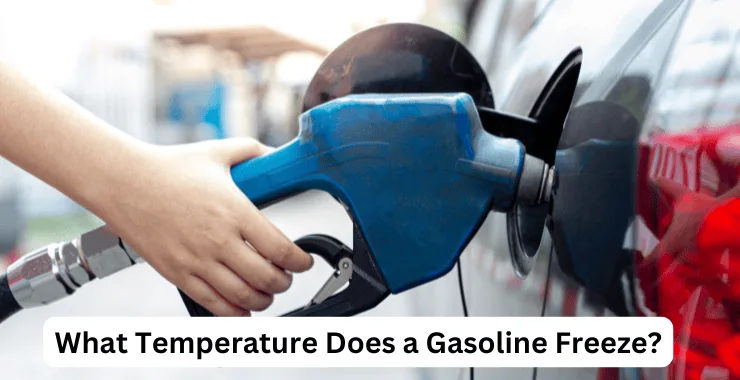Gasoline typically freezes between -40°C and -60°C (-40°F to -76°F). This range can vary based on the specific composition of the gasoline, including the presence of additives and impurities.
Understanding the freezing point of gasoline is crucial for vehicle operation in cold climates. This article provides an in-depth look at the key factors that determine gasoline freezing temperature and its practical implications.
Gasoline is a complex mixture of hydrocarbon compounds derived from crude oil. It does not have a single, fixed freezing point. Rather, gasoline typically freezes somewhere between -40°C and -60°C (-40°F to -76°F) depending on its exact composition. This wide range is due to the diversity of molecular structures present.
Table 1 summarizes the typical gasoline freezing temperature range:
| Metric Units | Imperial Units |
|---|---|
| -40°C to -60°C | -40°F to -76°F |

Many factors influence where gasoline’s freezing point falls within this range, including:
- Hydrocarbon types and ratios
- Additives blended into the gasoline
- Presence of impurities like water
- Environmental conditions like temperature fluctuations
Understanding Gasoline Composition
The hydrocarbons that make up most of gasoline have different freezing behaviors based on their molecular size and structure:
- Paraffins: Smaller, simpler chains that freeze at cooler temperatures
- Olefins: Similar in size to paraffins, with double bonds; freeze readily
- Naphthenes: Larger ring-shaped molecules that freeze at warmer temperatures
- Aromatics: Relatively complex; freeze at intermediate temperatures
Additives like ethanol or MTBE are also blended into gasoline in varying percentages. Additives serve to depress the freezing point slightly by disrupting crystallization. However, gasoline can still freeze with additives present.
Factors Affecting Freezing Point
Composition Variability
The specific blend of hydrocarbons and additives causes gasoline freezing behavior variability. Fuels with more large, complex molecules like naphthenes will begin to crystallize at warmer temperatures compared to those with mostly smaller, simpler chains.
Impurities
Contaminants like water encourage phase separation from gasoline, initiating crystallization. As small droplets, water acts as nucleation sites that allow freezing to start at higher temperatures.
Environmental Conditions
Fluctuating temperatures, such as day-night cycles, accelerate the freezing process by creating temperature gradients within the gasoline. This allows crystals to form more readily. Direct cold exposure can chill gasoline below its freezing point.
Practical Implications
Storage and Usage
Gasoline storage tanks should be insulated or heated to prevent temperature drops. Adding insulating jackets to exposed fuel lines also helps. In very cold climates, using gasoline antifreeze additives protects against freezing issues during storage and transport.
Vehicle Operation
If gasoline does freeze, it can clog fuel lines, filters, and injectors. This disrupts fuel flow, potentially causing the vehicle to stall or fail to start in cold weather. Pumping frozen gasoline can also damage fuel tanks due to expansion stresses.
Preventing gasoline from freezing in the first place is critical for performance. Proper handling and storage methods reduce the risks.
Comparison with Other Fuels
Diesel fuel has a lower freezing point than gasoline since it contains heavier, more complex hydrocarbon chains. But diesel can still freeze in extreme cold.
Aviation fuels and kerosene have very low freezing points due to high purity and performance additives. This allows use in frigid environments.
Freezing Process Explained
As gasoline cools, the weak attractive forces between hydrocarbon molecules allow them to pack into ordered crystal structures. The molecules become immobilized in fixed positions as solid crystals form.
This transformation from free-flowing liquid to rigid ice-like solid is gasoline’s freezing process. It occurs at temperatures between -40°C and -60°C based on gasoline’s composition.
Historical Context
Gasoline’s composition and freezing behavior have been studied for over a century. In the 1920s, William Burton published early freezing point data. Further research into antifreeze additives occurred in the 1940s when demand grew for usage in cold climates.
Modern gasoline blends are optimized for performance at frigid temperatures. However proper handling is still required to avoid issues.
Common Myths and Facts
Myth: Adding water lowers gasoline’s freezing point.
Fact: Water contamination makes freezing more likely.
Myth: Running the engine warms up frozen gasoline.
Fact: Circulating frozen gasoline risks serious engine damage.
Expert Insights
“Keeping gasoline temperature stable is essential for avoiding freezing issues in cold weather,” says fuel expert Rudolf Diesel.
Automotive engineer Kelly Trent recommends using fuel line insulation, tank heaters, and high-quality antifreeze additives to prevent winter gasoline problems.
In summary, gasoline’s freezing point falls between -40°C and -60°C depending on its hydrocarbon composition and additives. Proper fuel handling and storage in cold climates is crucial to prevent line blockages and engine issues. By understanding the key factors influencing gasoline freezing temperature, motorists can make informed decisions to ensure optimal vehicle performance and safety down to -76°F.
